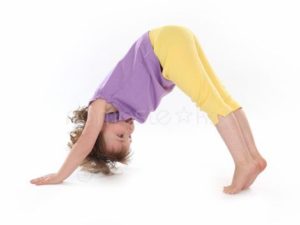Yoga for Kids
by Julia Meriwether
Student of Physical Therapy
The fundamental purpose of yoga is to promote balance in the body, mind, and environment. It is a low-impact form of physical activity which includes breathing techniques (pranayama), postures (asanas), relaxation and meditation.
Yoga at an early age encourages self-esteem and body awareness with physical activity that’s non-competitive which promotes cooperation and compassion. Yoga can provide numerous benefits both physical and mental including the following:
Physical
- Improved body flexibility, balance and coordination
- Improved cardiovascular endurance
- Increasing circulation, uptake of oxygen, and functioning of hormones
- Parasympathetic nervous system may become more dominant and stabilize the autonomic nervous system to enhance resistance to the effects of stress
- Improved abdominal strength
- Enhanced overall muscular strength
- Improved body awareness
- Improved motor planning
- Increased energy levels
- Weight control
- Enhanced immune system
- Improved digestion
Mental
- Increased focus and concentration
- Improved emotional control
- Teaches calming techniques
- Prevention and relief from stress-related disorders
- Intellectual enhancement, leading to improved decision-making skills
- Boosts self-esteem and confidence
- Strengthens the mind-body connection
- Improve prefrontal cortex function, including the ability to plan and execute complex functions
- Influence neurotransmitter function
Why yoga for kids?
Children are constantly told they need to be engaged and productive, leaping from one activity to another all day long, often right up until bedtime. Yoga teaches kids that it doesn’t have to always be like that. If children can learn how to relax and be still, they will be able to better handle the stressors and pressures as they get older. The greatest challenge for children is to hold their attention long enough to teach them the benefits of yoga – stillness, balance, flexibility, and focus.
Most kids love to talk, and they love to move—both of which can happen in yoga. Ask the child to assume the role of animals, trees, flowers, and warriors that the poses are named. For example, allow them to moo in cow pose, meow in cat pose, or hiss in cobra.
Here are some helpful tips when beginning to teach yoga to your young one:
- Model the pose, especially for the younger ones
- Start with the easier poses and progress to the more difficult ones to promote self-esteem and prevent being overwhelmed
- If they have difficulty with balance, let them start next to a wall or mat for stability








